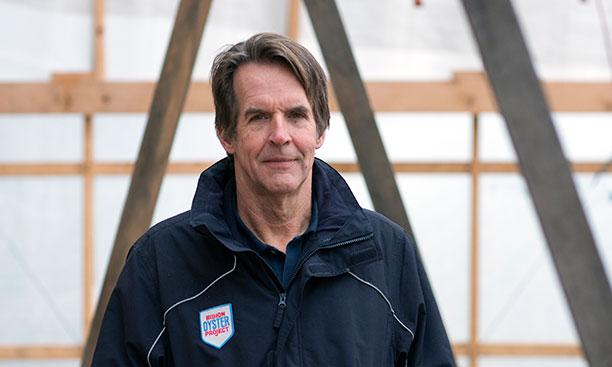
Rob Buchanan ’81 will be featured in the March 21 issue of PAW on the one-page photo and caption that opens the Princetonians section of the magazine. His story was so interesting, we’ve expanded here. Below, Buchanan talks about his life as a writer-turned educator/activist for New York City’s waterfront, harbor, and estuary.
Backstory: I was born in Redwood City, Calif., and grew up in Santa Cruz. I Graduated from Princeton and worked as a fact checker at Sports Illustrated. From 1984 to 2005 or so I was a magazine feature writer, mostly for Outside.
As a rower at Princeton, I wanted to continue once I'd moved to New York, but the harbor really isn't suited to skinny racing shells. One day, in the mid-’90s, I was riding my bike on the West Side when I saw some high-school kids rowing a traditional wooden gig — a long, narrow open boat that was much better able to handle the harbor's chop and slop. I started talking to the guy in charge and the next thing I knew I was volunteering for him, building boats in the lobby of a building on 49th Street. Eventually, I helped found a sister operation downtown, the Village Community Boathouse, where we build the same kind of boats. I'm not a great craftsman by any means but I'm a decent organizer, which is really what it takes to run a community boatbuilding program.
Teaching the Trade: From 2005-16 I taught journalism and environmental studies at Eugene Lang College (the liberal-arts division of The New School). I also got involved in a number of advocacy efforts centered around public access and clean water. At Lang, I introduced a course in which students built Whitehall gigs and used them to explore the harbor. In 2016, I took a job with an environmental nonprofit called Billion Oyster Project (BOP). Part of that job is running the afterschool boatbuilding program at the Harbor School, a maritime-themed public high school on Governors Island; the rest of the job involves supporting oyster restoration and urban-environmental education in New York City. I also coordinate the Citizens Water Quality Testing Program, a volunteer initiative that tests for sewage pollution at over 50 different launch sites around the harbor.
On the Waterfront: A concerning fact about NYC's waterfront is that we are lining it with Miami-beach style residential towers as fast as we can, even though it's obvious that the long-term viability of the city depends on us pulling back from, softening, and re-greening the edge. The reason I got into this whole thing —boatbuilding, and then the ecological restoration of the harbor and the estuary — started with the idea that the waterways are a public resource: Nobody owns them. If we're serious about taking care of them we need to have more access to them. Building boats is just a simple, very literal way to get to that goal.
Steady Ships: I started with Whitehall gigs, and that's what we're building now at the Harbor School, but my students have built lots of different boats: several smaller Whitehall rowboats and wherries, two stretched gunning dories, a Cornish pilot gig, and an umiak — a so-called “skin boat” with a thin membrane (used to be walrus skin, but we used ballistic nylon) stretched over a lashed frame. Last year at the Harbor School we completed a 21-foot New York Bay Sloop, a shallow-draft sailboat sometimes called a sandbagger.
The boats we built at The New School were all donated to the Village Community Boathouse. They're still in use there (the boathouse offers free public rowing on the Hudson two days a week in season). The boats we're building at the Harbor School will become part of the school's fleet and be used by students for training and racing.
Adventures on the Hudson: [From Manhattan] I’ve rowed up to the Erie Canal — the longest voyage I've taken in one of our boats — eight days. We've done a lot of other trips around Staten Island, out to and across Long Island Sound, down the Delaware, across Narragansett Bay — and also lots of races up in New England.
Today: Most of the work I do for NY Harbor Foundation (aka Billion Oyster Project) is centered around oyster restoration and field-science education; I'm often out in the field repairing broken gear or replacing oysters for public-school science teachers whose classes are monitoring the growth of their own 'adopted' mini oyster reefs. Boatbuilding is the other part of the job; in addition to supervising the afterschool program at the Harbor School, I'm also launching a new middle-school program this spring in Sunset Park, Brooklyn, where we'll be building a prototype “Brooklyn Oyster Dory.”
